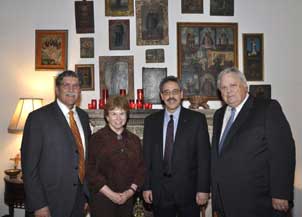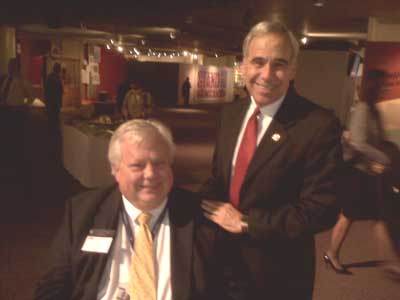are you wendish?
 This question has been on my mind since visiting the Institute of Texan Cultures to announce our new affiliation on January 28, 2010. Housed in the formidable Texas Pavilion, a landmark of San Antonio’s HemisFair Park, the Institute celebrates the diverse heritage of early Texans in its core exhibition, Texans One and All. Here one finds thoughtfully interpreted and artifact-filled displays of Mexican, African American, Czech, German, Jewish, and Lebanese Texans, among others, and…. Wends.
This question has been on my mind since visiting the Institute of Texan Cultures to announce our new affiliation on January 28, 2010. Housed in the formidable Texas Pavilion, a landmark of San Antonio’s HemisFair Park, the Institute celebrates the diverse heritage of early Texans in its core exhibition, Texans One and All. Here one finds thoughtfully interpreted and artifact-filled displays of Mexican, African American, Czech, German, Jewish, and Lebanese Texans, among others, and…. Wends.
A quick survey of friends and Smithsonian savants revealed that I was not alone in my unfamiliarity with this group of Texans. Wends it turns out are a Slavic people who began migrating into Germany and the Baltic region in the first millennium and have maintained their ethnic identity ever since. The Wends of Texas, better known as Sorbs or Lusatian Serbs, first arrived in Texas in 1853, settling in German speaking areas, and eventually populating the towns of Serbin and Giddings.

UTSA President Dr. Ricardo Romo; Dr. Harriett Romo Director of UTSA CAPRI/MEXICO CENTER; Harold Closter, Director of Smithsonian Affiliations and Tim Gette, Executive Director, ITC.
The Institute of Texan Cultures, organizer of the Texas Folklife Festival, served as a catalyst for the revitalization of Wendish culture in Texas through its annual call for festival participants, which helped to launch the Texas Wendish Heritage Society. Today, according to the Institute, “the community at Serbin holds an annual Wendish Fest and extends a welcome, Witajcže K’nam, to visitors. During the affair church services are conducted in German and English, a Czech band may play, and corn-shucking contests are held. Some of the local descendants dress in European Wendish costume.” The Institute emphasizes colorful Wendish wedding traditions in its display.
This is just one of the many stimulating encounters to be found at the Institute of Texan Cultures. It is not surprising that a state with so much space and so many natural resources would be a magnet for so many different people. Whether familiar or not, there is always much to learn about the heritage of our predecessors, and the adaptations and sacrifices made or forced upon them. At the Texas banquet table, diversity is served in complex and compelling dishes. There’s room for all at this enormous spread….including the Wendish.

Tim Gette and Congressman Charles A. Gonzalez (TX-20) at ceremony announcing the affiliation between the Institute of Texan Cultures and the Smithsonian Institution.
Stop by the Institute of Texan Cultures when you are next in San Antonio and offer a hearty Witajcže K’nam. They’ll know what you’re talking about.



My great-Great-Great grandfather, Johann Hohle, was aboard the Ben Nevis and helped settle Serbin, TX.
Greetings! Wonderful message, however I would like to interject the term “Lusatian Serbs” is not all well received by the Sorbs in Europe. It is a topic of much heated debate whenever it is brought up.
I hope your banquet includes Wendish noodles, always a delight!
The great majority of Wends came to Texas in 1854 aboard a single ship, the Ben Nevis, which docked at Galveston with about 500 passengers. This and other information about the Wendish culture are available at the Texas Wendish Heritage Society’s comprehensive website at https://www.texaswendish.org.